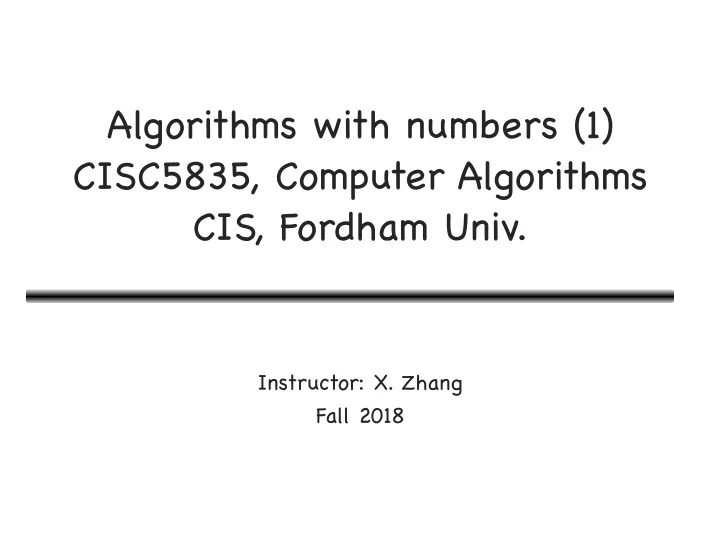

Algorithms with numbers (1) CISC5835, Computer Algorithms CIS, Fordham Univ. Instructor: X. Zhang Fall 2018
Acknowledgement • The set of slides have used materials from the following resources • Slides for textbook by Dr. Y. Chen from Shanghai Jiaotong Univ. • Slides from Dr. M. Nicolescu from UNR • Slides sets by Dr. K. Wayne from Princeton • which in turn have borrowed materials from other resources • Other online resources 2
Outline • Motivation • Algorithm for integer addition • Algorithms for multiplication • grade-school algorithm • recursive algorithm • divide-and-conquer algorithm • Division • Exponentiation 3
Algorithms for integer arithmetics • We study adding/multiplying two integers • earliest algorithms! • mostly what you learned in grade school! • Analyze running time of these algorithms by counting number of elementary operations on individual bits when adding/multiplying two N-bits long ints (so called bit complexity) • input size N: the length of operands • for example, to add two N-bits integer numbers, we need to O(n) bit operations (such as adding three bits together). 4
Practical consideration • But, why bother? • Given that with a single (machine) instruction, one can add/subtract/multiply integers whose size in bits is within word length of computer – 32, or 64. • i.e., they are implemented in hardware • Bit complexity of arithmetic operations algorithms captures amount of hardware (transistors and wires) necessary for implementing algorithm using digital logic circuit. • e.g., number of logic gates needed … 5
Support for Big Integer • What if we need to handle numbers that are several thousand bits long? • need to implement arithmetic operations of large integers in software. • Ex: Use an array of ints to store the (decimal or binary) digits of integer, • int digits[3]={2,4,6}; //represents 642 • int digits1[10]={3,4,5,7,0,7,8}; //represent 8707543 • int bindigits[4]={1,0,1,0}; //represent 0101, i.e., 3 • Algorithms studied here are presented assuming base 2 • those for other base (e.g., base 10) are similar 6
Support for Big Integer* • But notice that each int variable can store up to 64 bits, and we can add/subtract/multiple 64-bits ints in one machine instruction • To save space and time, one could divide big integer into chunks of 63 bits long, and store each chunk in a int • 101100… 10 1111110…101110 111111…0000110011110111 63 bits 63 bits 63 bits • int chunks[3]={32, 121254, 145246}; //represent a value of When adding two numbers, adding corresponding chunks together, carry over are added to the next chunks… 7
Outline • Motivation • Algorithm for integer addition • Algorithms for multiplication • grade-school algorithm • recursive algorithm • divide-and-conquer algorithm • Division • Exponentiation 8
Adding two binary number 9
Algorithm for adding integers • Sum of any three single-digit numbers is at most two digits long. (holds for any base) • In binary the largest possible sum of three single-bit numbers is 3, which is a 2-bit number. • In decimal, the max possible sum of three single digit numbers is 27 (9+9+9), which is a 2-digit number • Algorithms for addition (in any base): • align their right-hand ends, • perform a single right-to-left pass • the sum is computed digit by digit, maintaining overflow as a carry • since we know each individual sum is a two-digit number, the carry is always a single digit, and so at any given step, three single-digit numbers are added) 10
Sorting applications 11
Ubiquitous log 2 N • log 2 N is the power to which you need to raise 2 in order to obtain N. • e.g., log 2 8=3 (as 2 3 =8), log 2 1024=10(as 2 10 =1024). • Going backward, it can be seen as the number of times you must halve N to get down to 1, more precisely: • e.g., N=10, ; N=8, • It is the number of bits in binary representation of N, more precisely: • e.g., hw1 questions • It is the depth of a complete binary tree with N nodes, more precisely: • height of a heap with N nodes … • It is even the sum 1+1/2+1/3+...+1/N, to within a constant factor. 12
Multiplication in base 2 The grade-school algorithm for multiplying two numbers x and y: • create an array of intermediate sums, each representing the product of x by a single digit of y. • these values are appropriately left-shifted and then added up. 13
Multiplication in base 2 If x and y are both n bits, then there are n intermediate rows, with lengths of up to 2n bits. The total time taken to add up these rows, doing two numbers at a time, is which is O(n 2 ). 14
Multiplication: top-down approach • Totally, n recursive calls, because at each call y is halved (i.e., n decreases by 1) • In each recursive call: a division by 2 (right shift), a test for odd/ even (looking up the last bit); a multiplication by 2 (left shift); and possibly one addition => a total of O(n) bit operations. • The total time taken is thus O(n 2 ). 15
Divide-and-conquer 16
Running time Our method for multiplying n-bit numbers 1. making recursive calls to multiply these four pairs of n/2-bit numbers, 2. evaluates the above expression in O(n) time Writing T(n) for the overall running time on n-bit inputs, we get the recurrence relation: T(n) = 4T(n/2) + O(n) By master theorem, T(n)=(n 2 ) 17
Can we do better? By Master Theorem: 18
Integer Division 19
Readings • Chapter 1.1 20
Recommend
More recommend